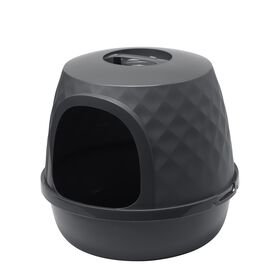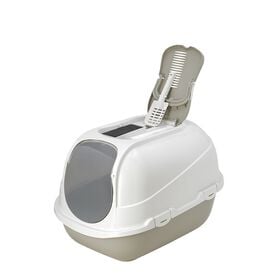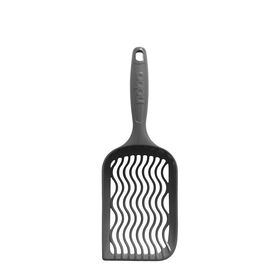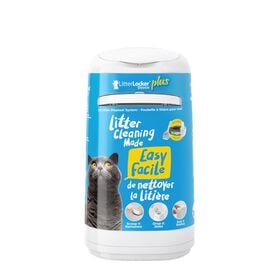
The cat is one of the rare domestic species that can use a specific location to do its business almost instinctively. In this article, we will explore the reasons why the cat has this ability to do its business in a litter box, why it sometimes chooses to do it outside its box (like on the living room carpet or the bed) and how to avoid mishaps.
Cat behaviour
We know the cat is a territorial animal. What is not common knowledge is the fact that the cat divides its territory in different zones, each with a specific function. There is the social interaction zone, the isolation zone, the hunting zone and, of course, the elimination zone which is called the latrine. The cat chooses its latrine with very specific conditions in mind. We must first mention that the cat is able to find its latrine using two tools at its disposal. The cat has an excellent cartesian memory which gives it a very sharp orientation sense. And it uses the odour left by an hormone that can be found in the cat’s urine to more efficiently find its latrine.
The litter box : the cat's "bunker"
The location is usually far enough from the hunting zone but close enough to the other zones. It is often set back however not completely isolated. The latrine is normally positioned in a way that the cat can be hidden while being able to watch over its environment. There will also be many ways to flee in case a danger comes its way.
Why does a cat bury its faeces?
The latrine is big enough so that the cat can urinate and poop in different places and has the possibility to bury its faeces efficiently. Why does a cat bury its faeces? Well, because the cat is in the middle of the food chain, it has as many predators above it as preys below. Therefore, the cat buries its faeces to eliminate all traces that potential predators and preys might smell and give it away.
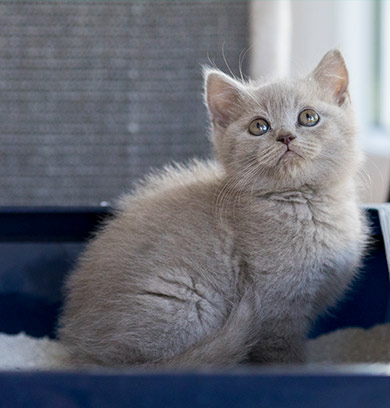
A Learning process
The act of burying is instinctive for the cat but the way to it is learned. Kittens will look at their mother, brothers and sisters and other adult cats bury their faeces and then imitate their behaviour. This can explain why some cats scratch the sides of the litter box instead of the grains in the box. In fact, these cats were probably raised in a house where litter boxes were covered or the sides too high, preventing them to see what the adult cats were actually doing. They heard the scratching but could not see. So they assumed the sound came from scratching the sides of the litter box.
Marking its territory
But the cat does not urinate only to eliminate. It also uses its urine to mark its territory. To better understand, when a cat marks its territory, we can imagine it is sticking a sign saying "Careful! Private territory! No trespassing allowed". However, the way a cat urinates when it marks its territory is quite different than when it eliminates. Territorial marking is done outside the latrine and often consists of a small urine gush aligned on a vertical object (less often on a horizontal object) that leaves a particularly strong odour.
Females do it too
Contrary to general belief, males are not the only ones marking their territory, females do it too. Furthermore,the majority of non sterilised males will invariably mark their territory, starting a the early age of 7 to 10 months, inside and outside. This is why sterilising your cat, male or female, will drastically minimize its chances of marking its territory.
Why choosing the bed or sofa?
Anxiety and fear are other reasons that can explain why a cat eliminates outside its litter box at home. An anxious cat or a cat that is afraid might urinate in specific locations like the sofa or the bed to try to reassure itself. Why the sofa or the bed? Simply because these places are where the masters’ odours (security) are the strongest.
Get the proper litter box
The litter box in a home replaces the latrine outside. The litter box must therefore meet the same criteria as the latrine. The litter box must be big enough. The litter box is big enough when three cats can fit inside the box.
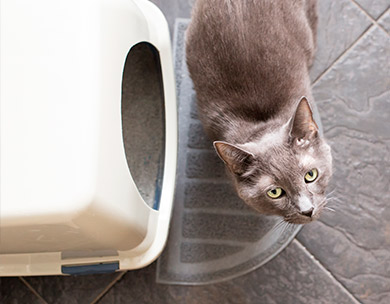
Help your cat feel secure
The litter box should not be covered so that your cat can watch its environment for predators or preys. Your cat must feel safe like when it chooses the location of its latrine outside.
More boxes than cats!
The number of litter boxes is also very important. The rule is simple: there must be the same number or boxes as there are cats plus one. You have two cats? You need three litter boxes. Even if you only have one cat, you need two litter boxes. Like in nature where the size of the latrine lets the cat separate its urine from its poops, the cat needs the possibility to do the same thing inside: one box for its urine and one box for its poops. If your cat has a tendency to do its faeces just outside its litter box, it might be explained by the fact that it does not accept to mix urine and poop together.
Cleaning the litter box
It also frequently happens that a cat does not accept to do its faeces in a litter box that has already something in it. In this case, having more than one litter box can limit the damages. Furthermore, cleaning the litter regularly becomes important.
How much grain
How much grain should you put in the litter box? Approximately 3 to 4 inches, just enough so that the cat can scratch almost to the bottom of the box without quite reaching it.
By following these tips, you make sure that the litter you offer to kitty meets his needs and you avoid the inconvenience of inappropriate disposal on the bed or couch! If you constantly have problems with your cat and its litter, do not hesitate to seek the services of a feline behavior specialist.





